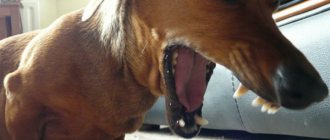Symptoms
If a dog swallows a bone and chokes, the animal will experience the following symptoms:
- the pet cannot swallow. This manifests itself during feeding. The pet begins to cough while swallowing food;
- The dog often swallows saliva. This is a protective reflex, the animal thus tries to swallow a foreign object;
- the animal whines. Most often this occurs after eating food. A foreign object can damage the intestine and pain occurs when eating food;
- cough;
- bile is secreted;
- the animal behaves lethargically, refuses food and games;
- wheezing appears when exhaling air;
- uncontrolled abundance of saliva. If an object is stuck in the throat, saliva accumulates and flows out.
Another symptom is the presence of blood in the stool. A sign appears after a sharp object damages the intestine.
Note! If any symptom appears, you should immediately contact a veterinarian.
Possible symptoms
Dog vomits yellow
If there is yellow mucus or foam on the floor, this indicates a malfunction of the gastrointestinal tract, as a result of which bile from the upper part of the small intestine ends up in the stomach. It irritates the walls of the sphincters and the internal epithelium of the stomach, causing the organ to contract and push bile out.
The dog owner will notice that after the first attacks, thick yellow mucus remains, and when acts of vomiting are repeated, foam comes out. This is due to the limited volume of gastric juice with which bile mixes.
If food remains are not found in the vomit, then you can be sure that the acute condition that caused the vomiting developed after the last feeding. The food was digested and evacuated into the intestines.
The most common cause of yellow vomit in dogs is diet failure. More often, the condition occurs after feeding fatty and tasty food, but not suitable for a four-legged friend. For small dogs, it is enough to taste a little pork kebab; for large dogs, vomiting will be caused by porridge cooked in jellied meat, the addition of a large amount of fat, pork legs, broth on a pig's head, and more.
If there were such errors in the diet, then there is no reason to worry. It is enough to support the gastrointestinal tract by prescribing antispasmodics, anti-inflammatory drugs and adsorbents. The schedule for taking medications must be prescribed by a veterinarian. He will also be able to calculate appropriate doses.
It is important for animal owners trying to provide first aid on their own to remember that other medications should not be given together with adsorbents. Otherwise, their actions are nullified.
An animal with a breakdown in food adaptation is lethargic, gets up and walks reluctantly, but will not refuse to sniff a piece of something tasty, and may even make attempts to eat it. It is not worth feeding on the first day after yellow vomiting. It is necessary to allow the excited gallbladder, damaged stomach and intestines to calm down.
The best type of food during the rehabilitation phase will be low-fat kefir, white bread crackers, soaked in chicken breast broth. You need to return to your usual diet slowly and carefully. In the future, you should avoid fatty, fried and spicy foods.
If, before yellow foam and mucus appeared in the vomit, the dog gave out a portion of food, then it is important for the owner to remember how many hours ago the last feeding was. Breakfast or dinner, which took place several hours ago, has not yet been digested. But if the dog ate 6-8 hours ago or more, then pieces of food in the vomit will alert the veterinarian. They indicate that movement into the intestines and digestion is impossible. This may indicate partial or complete blockage of the intestinal lumen, severe spasm that makes peristalsis impossible, the onset of acute dilation of the stomach, and much more. In this case, the dog must be immediately diagnosed and treated.
Vomiting of white foam or white mucus occurs with helminthic infestation. The absence of yellow inclusions indicates that bile does not enter the stomach from the intestines.
Between meals, the dog produces a small or voluminous puddle of white foamy substance. This is gastric juice. The reasons for the contraction of the stomach lie in the processes occurring in the small intestine. If helminths live there, they produce toxins, as a result the dog experiences increased gas production. The intestines put pressure on the lower part of the stomach, which gets rid of gastric juice by vomiting.
The same mechanism is activated during natural gas formation without the participation of helminths. If the process of producing digestive enzymes in the bile and the secretion of the pancreas is disrupted, then the food is not digested, but ferments. If the process occurs in the upper intestines, this leads to vomiting. Gas formation in the second half of the large intestine will cause foul-smelling farts.
It is important for owners to examine the contents of white vomit in dogs. In it you can notice white inclusions or an object resembling a thick thread. These are living or dead helminths. By their appearance, you can determine their names and select an anthelmintic drug. If the owner is not sure that he can explain to the veterinarian exactly what he found in the white foam with or without food, then it is reasonable to take a photograph of the vomit.
Ineffective retching is a rare physiological condition in dogs that occurs when the stomach is empty. The animal has already vomited the synthesized gastric juice, but the new one has not yet formed. The processes of sharp contraction of the stomach cause pain, the owner needs to relieve attacks of ineffective vomiting. To avoid harm by taking medications incorrectly, it is better to consult a veterinarian.
The dog swallowed chicken bones
Chicken bones for dogs can only be used from broiler chickens. Birds raised in poultry farms have weak bones that do not form sharp edges when bitten. However, if your dog has eaten a chicken bone from domestic chickens, you need to know what to do in such cases. Village birds have a strong skeletal system, so it can damage the intestines and lead to the death of the animal.
Damage to bones for dogs
First aid if a dog has swallowed a foreign object
The symptoms of a foreign body in a dog depend greatly on where the object is located - in the mouth, throat or esophagus, stomach or intestines. I urgently need advice. There is an assumption that my dog swallowed a needle or part of it. She shows no visible concern. A foreign body in the dog's rectum: if it is sharp objects - sticks, bone fragments, needles, etc.
Dogs are very curious by nature. Gastrointestinal tract of dogs: socks, panties, bags, ropes, threads, needles, toys, bones, sticks and many other finds! A foreign body in a dog's mouth is usually sticks or bones that are stuck between the dog's back teeth.
As first aid, the owner can lift the dog by the hind legs and shake it; in an emergency, you can sharply squeeze the chest from the sides several times.
Some foreign bodies can remain in the stomach for several years without visible problems. A foreign body in a dog's small intestine usually causes uncontrollable vomiting, dehydration, and severe pain in the abdominal wall.
Almost all foreign bodies in the gastrointestinal tract are objects that are consumed by the animal.
Diagnosis requires a general blood test, biochemical blood test, and urine test. These findings help rule out other causes of vomiting, diarrhea, anorexia, and abdominal pain.
All these research methods are used in veterinary clinics of the Svoy Doctor network.
A foreign body in a dog that causes intestinal obstruction, prolonged vomiting, or diarrhea can lead to significant metabolic changes in the body.
Many foreign bodies consist of toxic materials that are absorbed by the body - this leads to profound systemic diseases. There are several treatment options depending on your dog's condition.
If the animal has symptoms such as vomiting blood or severe pain, then intravenous infusions and painkillers are necessary. Your veterinarian will suggest admitting your dog to the clinic for observation.
If there are necrotic tissues and parts of the intestine, they are also removed. In most cases, dogs with foreign bodies that do not cause blockages have a good prognosis. The impression is that nothing bothers her anywhere. But after the walk, while eating, I coughed a couple of times, as if something was stuck in my throat.
Hot on the heels, they usually do this: take cotton wool, straighten it, making a canvas with an area of approximately 8x8 cm, pour in vegetable or petroleum jelly oil and let it be swallowed. There will be perforation of the wall.
Source: https://prikaziwon.ru/sobaka-proglotila-inorodnoe-telo-vash/
The dog ate a fish bone
The fish bone is small in size. It is quite sharp and if it gets into the throat it can pierce its walls and cause pain to the pet. The first symptoms that an animal has swallowed a bone are insomnia and refusal to eat. Often the animal begins to whine while feeding. If a dog swallows a bone, every pet owner should know what to do in such a situation. You need to do the following:
- with the help of outside help, open the dog’s mouth wide and examine the throat;
- carefully examine the animal's teeth. Fish bones can get stuck between teeth;
- If the bone is noticeable, use tweezers to remove it.
Note! If there is no bone in the mouth and throat, and the dog continues to feel unwell, it is necessary to visit a veterinarian.
The dangers of fish bones
What should an owner do if a dog vomits?
First of all, do not scold or punish your dog, even if he vomited on an expensive carpet or car seat. A dog cannot control its reflexive urge to vomit, no matter how trained it is. In addition, harmful substances are eliminated through vomit.
If you see that the dog is about to vomit, and it is wearing a muzzle or a tight collar, remove the equipment, otherwise the animal may choke on the vomit.
It will be easier for your veterinarian to determine the cause of vomiting if you provide him with as much information as possible about the dog, namely:
Frequency of vomiting; when the dog vomits: after eating or before eating; the nature of the vomit (consistency, color, smell, presence of fragments of undigested food, worms, foreign bodies, etc.); information about the dog’s condition, its tone, appetite, the presence of other symptoms of the disease (constipation or diarrhea, lack of appetite, increased thirst, lacrimation, nasal discharge, increased or decreased temperature, etc.); circumstances of the last 2-3 days before the onset of vomiting. Perhaps the diet was changed dramatically, or the dog ate something while walking, or came into contact with a sick animal.
In any case, if there is excessive frequent vomiting, measures must be taken to prevent dehydration before the veterinarian arrives. If the dog does not drink on its own, it is necessary to pour water or a rehydron solution into its mouth.
Vomiting blood
If there is an admixture of blood in the vomit, you should immediately contact a veterinarian.
Bloody vomiting can be caused by gastric bleeding. Gastric bleeding occurs when the stomach wall is injured by foreign objects, poisoning, infectious diseases, stomach ulcers or cancer.
If the bleeding is not heavy, the vomit will appear dark brown or black. With profuse bleeding, the blood in the vomit is light, bright, and this is an extremely dangerous symptom.
.
Vomiting as one of the symptoms
If a dog vomits on an empty stomach or immediately after eating, there is reason to suspect the presence.
If vomiting occurs several hours after eating, it is possible that a foreign body has entered the stomach or a tumor has formed.
Morning vomiting of foamy, yellow mucus may indicate indigestion or pancreatitis. In some diseases, vomiting is combined with an unpleasant odor from the dog's mouth. If you have kidney failure, you may smell ammonia. In diabetes mellitus, the mouth smells of acetone, and the smell of rot indicates problems with teeth and gums, as well as pathological processes in the intestines.
Vomiting and refusal to feed are the most common combination of symptoms. The cause of lack of appetite may be the onset of an infectious disease or poisoning. Let your dog fast and monitor his condition carefully. If you notice a rise in temperature or diarrhea, consult a doctor immediately, as such a set of symptoms may indicate the onset of an acute infectious disease (, etc.).
Vomiting can be caused by intestinal obstruction and foreign bodies in the gastrointestinal tract. The presence of intestinal obstruction can be assumed when the dog does not have stool and often vomits. Intestinal obstruction develops due to intestinal or stomach volvulus, and can also occur due to the animal swallowing toys, stones, bones, etc. It is necessary to examine the dog as quickly as possible and, if necessary, perform surgery. The less weakened the dog is, the easier it will tolerate surgery and anesthesia.
If vomiting is accompanied, this may indicate a wound in the pharynx or oral cavity.
Often, while walking, a dog finds and eats hard blades of grass, and then vomits it. If this does not happen too often and the dog’s health remains good, then there is no reason to worry - your pet is simply cleaning its stomach in the same way as its wild ancestors did.
However, in some cases this occurs due to helminthic infestation or improper feeding of the animal. Pay attention to the presence or absence of other symptoms - diarrhea or constipation, belching after eating, the condition of the coat may indicate possible problems.
If you are concerned, don't hesitate to call your veterinarian for advice. It’s better to be safe than to lose your dog due to your own sluggishness.
Vomiting is a common occurrence in almost all animals. It cannot be interpreted as a separate disease, because it is only a symptom. There can be many reasons for vomiting and nausea: worms, chronic liver disease, poor-quality food poisoning, indigestion, overeating, stress, heat stroke, motion sickness and much more.
As you can see, nausea can be either normal or indicate the presence of a serious illness. It is necessary to constantly monitor the dog in order to take it to the veterinarian on time.
The dog ate a tubular bone
Tubular bones are very dangerous for the animal. They all form sharp edges. In addition to damage to the digestive organs, the following problems may occur:
- damage to the oral cavity when biting a bone;
- bones may contain harmful bacteria, which, once in the dog’s body, can lead to the development of infection;
- The dog can't go to the toilet. Bones lead to constipation, which also negatively affects the pet’s well-being.
The long bones of cattle can block the respiratory system, causing the animal to suffocate and possibly die.
Important! Tubular seeds retain their structure even after cooking. Also, when boiling, most of the harmful microorganisms do not die.
Foreign body in the intestine of a dog
One of the causes of damage to the gastrointestinal tract in dogs is a foreign body that, for various reasons, was swallowed by the animal. This often happens during active play (small toys, chewing large objects into pieces), eating (large bone fragments, eating packaging), as well as when a dog eats inedible objects on the street. A variety of foreign bodies are found in the gastrointestinal tract of dogs - from pieces of polyethylene and fragments of toys to items of clothing of the owners.
Actions if your pet is choking
If a dog swallows a bone whole, you need to know what to do.
Puppies and small breeds
Bones for small breeds can be very dangerous. Puppies need to be especially closely monitored. You need to know what to do if your puppy eats a bone and problems arise. The algorithm of actions should be as follows:
- open the mouth and carefully examine the throat with a flashlight;
- Make sure the dog can breathe normally. Very often the bones block the airways;
- holding the animal by the hind legs, lift it slightly;
- If there are symptoms of suffocation, the puppy should be pressed to the knees and with sharp movements of the palm, press the diaphragm.
What to do if your dog is vomiting foam?
To eliminate the above symptoms, it is important to identify the disease. There is no need to treat vomiting.
So, what should you do if your dog vomits white foam? The answer is obvious - look for the reason for this. Of course, a visit to the veterinary clinic will help here, where your pet will have a blood test and an abdominal x-ray. Only based on the results of the examination and tests can the source of this symptom be determined.
But it also happens that the dog vomits, but it is not possible to get to the veterinarian quickly. Then you need to adhere to certain rules. First of all, you should rid your pet’s body of suspected poisoners or irritants. In this case, he is not fed or sung for a day, but is only allowed to lick ice cubes.
When this helps and the vomiting stops bothering you, you can feed a small amount of chicken broth. Next, you can offer pureed white meat chicken or turkey breast. At the same time, you should feed your pet in small doses 4-6 times a day, adding fresh herbs and brown rice to the food to strengthen the stomach if diarrhea is also bothering you. You can start giving your usual foods from the third day.
Suitable medications include No-shpa, Papaverine, Smecta, Cerucal, Omez. They relieve spasms in the stomach and intestines. Otherwise, medications can only be prescribed by a specialist. Self-medication is unacceptable, it can cause harm.
What should you do if your dog vomits yellow foam? As noted above, it is also good to keep her on a diet, paying attention to her behavior. If the vomiting of bile stops and the condition improves, there is no need to worry. Often a well-developed diet and diet can solve the problem.
But when a dog vomits several times a day, it should be taken to a veterinary hospital so that competent measures can be taken in time. As you can see, external eruptions from a dog’s mouth do not always indicate a dangerous condition of the animal. Often the reason for this symptom lies in inattention to the pet.
And how can one not remember the wise words about responsibility for those whom they took in? So if you decide to have a pet, give it the time it deserves. Remember that his feeding should be varied and complete, and walks should be constant, at least 2-3 times a day. To this should also be added vaccinations on time and various preventive measures. Only this approach can ensure the health of your four-legged friend.
Therefore, if you decide to have a four-legged friend, think carefully about whether you are capable of such sacrifices on your part. After all, your animal may be sick, and its recovery will depend only on you.
The dog is vomiting
, the owner is often confused, worries about his pet and tries to help him.
Vomiting in dogs
can be a consequence of poisoning, overeating bones, and sometimes it is necessary to induce vomiting on purpose. But still, vomiting is not always dangerous for the dog’s health; it is a natural process of cleansing the body.
Have you ever watched in disgust and bewilderment as your dog, who has just vomited on the mat, frantically tries to eat his own vomit? This may seem strange to us, but in the dog world it is par for the course.
Dogs tend to eat what they vomited for two reasons:
- the first is a dog - mom could burp for them when they were puppies;
- second, the heightened sense of smell detects particles of undigested food in the vomit.
Some types of vomiting are normal in dogs.
For example, if the reason for vomiting is:
- the dog ate too quickly or too much,
- stomach irritation,
- nervousness.
In these cases, there is nothing to worry about.
You should also be aware that puppies and older dogs are more likely to vomit. Follow the general guidelines and don't worry too much. These are features of their age.
But sometimes the presence of vomiting can indicate a serious illness. If the dog vomits
once or more times a week, and vomiting is accompanied by diarrhea, lethargy, or loss of appetite, consult your veterinarian immediately!
This may not seem important, but you will know when your dog begins to vomit. Knowing these signs can help you lay down paper towels, newspapers, or recognize a situation where you need immediate veterinary attention.
Signs of vomiting in a dog:
- Sounds like something is stuck in the dog's throat.
- The throat is tense, as if the dog wants to push something out.
- Stiff stance - the dog is trying to stop himself from vomiting.
- The dog is wandering aimlessly.
The dog swallowed the bone without choking
In some cases, the animal will swallow the bone without causing any symptoms. In such cases, the following recommendations must be followed:
- Do not give the animal solid food for 3 days. If the bone is stuck, hard food can cause further tearing of the soft tissue;
- feed the dog liquid oatmeal. The dog should eat at least 500 grams of liquid porridge daily. It is recommended to add a few tablespoons of vegetable oil to the porridge;
- keep an eye on the stool. If the bone has not damaged the tissue, the animal should go to the toilet regularly. The remains of the foreign object will be passed out along with the feces.
It is also necessary to give the dog water 2 times a day. If the animal refuses, the water is filled with force. Lack of water can lead to dehydration.
Important! Some owners do not feed the animal for several days. Such actions are incorrect, since the bone will move through the empty digestive organs and in the process damage them.
The pet ate too many bones
If your dog has eaten too many bones, you need to know what to do to cleanse the intestines. Overeating is often accompanied by constipation. Therefore, it is recommended to increase the amount of fluid consumed. Using a small syringe, inject 50 grams of Vaseline oil into the mouth.
Why does the dog vomit?
Vomiting often causes fear on the part of the dog owner. There's really nothing to be afraid of here. Vomiting is not a separate disease. Usually this is a symptom indicating a particular ailment. But when such a condition causes anxiety in your pet, he hides somewhere far away, licks his lips, and actively salivates - this is a clear reason to take action.
A dog may have this condition for a number of reasons:
- poor quality, as mentioned above, or unacceptable food, in particular eating habits
- the presence of foreign objects in the stomach, which dogs sometimes swallow;
- acquisition of a viral infection - enteritis, plague;
- the appearance of worms, especially in puppies;
- intoxication with toxic substances;
- stressful condition.
The occurrence of such a symptom after a morning meal gives reason to assume gastritis. If vomiting occurs some time after eating, it can be assumed that there is a foreign object in the stomach or neoplasms in the gastrointestinal tract. Constant eruptions indicate the possibility of cholecystitis, or hepatic colic.
In addition to the above signs, harbingers of canine illnesses are also:
- salivation, whining and tossing back and forth (the pet cannot find a place for itself);
- vomiting with blood - a condition indicating a severe infection or erosion of the mucous membrane;
- diarrhea, fever with vomiting - also indicate infection, in addition, indicate the possibility
- the occurrence of rapid exhaustion;
- the smell of ammonia from the mouth is a clear symptom of a disease of the urinary system.
Warning sign
It is not so rare that an animal produces white foam along with vomiting. There are several sources for this condition. One of them, and the most important one, is the emptiness of the stomach. In this case, it will definitely be enveloped in mucus. It is this that comes out along with the foam, which is formed as a result of air swallowed by the animal entering the stomach.
Why does a dog vomit white foam and what should be done in this case? You don't need to do anything when it happens once. But if, along with vomiting, there is a deterioration in her health, rush your pet to the veterinarian.
It's very bad when this happens on an empty stomach. Such a symptom may mean a severe infection with worms. In this case, they need to be driven away with special drugs. Among the diseases that are observed in dogs that vomit white foam, the following should be highlighted:
- various types of intoxication of their body;
- intestinal blockage;
- presence of a foreign object in the stomach;
- inflammation of the pancreas and intestines;
- ailments of the central nervous system;
- traumatic brain injuries;
- hydrocephalus, brain tumors;
- oncological diseases;
- hepatitis, plague, enteritis;
- volvulus;
- leptospirosis, helminthiasis;
- coronavirus infection.
- churning in the stomach
Of course, this is an incomplete list of ailments. As already noted, this condition with white mucus may indicate the presence of gastritis. And this, in turn, is the result of errors in nutrition. If vomiting is frequent, then this directly indicates an intestinal blockage, severe infection, or an inedible object entering the stomach.
In order not to be mistaken in determining the disease, veterinarians recommend that owners make an hourly record of what, in what volume and when their pet vomited. Vomiting with white viscous foam indicates a dangerous disease such as rabies. Of course, this symptom alone cannot identify this disease with 100 percent probability. But if the dog suddenly goes numb, eats inedible objects, is afraid of water, etc., there is no doubt.
When a dog coughs and vomits white foam, it is very serious. And making a diagnosis on your own is not so easy. After all, this condition often occurs due to different types of viruses: parainfluenza, rhinoviruses, adenoviruses, etc.
This condition is not so harmless for a dog, because a viral infection, as a rule, is the root cause of bacterial complications. Therefore, the affected animal may not only cough and vomit white foam, but also suffer from suffocation. In short, there can be many reasons for a dog to vomit with white foam. So, the more severe and prolonged the attacks, the sooner you should take her to the vet.
About symptoms with yellowness
When a pet spews a yellow foamy mass, then, quite understandably, we are talking about an admixture of bile. As in the first case, it will be useful to figure out why the dog is vomiting yellow foam.
It should be noted right away that a similar phenomenon occurs in animals that are fed once a day. Naturally, you can correct this situation yourself by changing your feeding schedule. It is better to feed your four-legged friend 2-3 times a day, dividing the usual daily portion according to this change.
It happens that dogs eat grass and then vomit bile. This usually happens in the morning. We need to follow them. If your appetite is good and your stool is normal, you can rest assured. As a rule, the animal cleanses its stomach in this way.
But this condition can also be the result of poor nutrition, which causes the pet to have excess bile in the body. Then keep him on a diet. In this case, fasting for 24 hours will be helpful. After this, his condition should return to normal.
But when there are worms or blood in the dog’s yellow vomit, you need to drop everything and urgently take him to the clinic. There can be no hesitation if you don’t want to lose your four-legged friend.
When to contact a veterinarian
The following factors may be reasons to contact a veterinarian:
- the dog whines while eating food;
- after going to the toilet, stool mixed with blood is discovered;
- The dog refuses food and behaves restlessly.
Visit to the veterinarian
After swallowing bones, especially tubular ones, experts recommend taking an x-ray to make sure that the foreign object has not caused damage to the soft tissue. If there are scratches and wounds, treatment and a special diet are prescribed.
Important! Bones that have damaged the intestine and cannot come out naturally on their own are removed by surgery.
Consequences
The consequences after eating bones can be different. Some large pets, after swallowing, digest a foreign object without harm to the body. However, there are often cases where bones damage the integrity of the digestive organs. In such cases, inflammation begins.
What not to do
If foreign objects are swallowed, the following actions are prohibited:
- should not induce vomiting. This can lead to mechanical damage to the digestive organs;
- do not use enemas or laxatives;
- Do not give your pet solid food to push through a foreign object.
It is forbidden to treat your pet yourself. Medicines should be used only after a doctor's prescription.
Causes of the condition
In animals, vomiting is a reflex action aimed at spontaneous cleansing of the stomach contents. It is certain that such a protective reaction helps the body get rid of harmful substances, as well as foreign bodies or objects that have entered the digestive system. In some cases, the gag reflex accompanies severe emotional shocks, cerebrovascular accidents, serious concussions and head injuries.
Important! Some dogs react strongly to changes in food. Therefore, if diarrhea and vomiting occur in a pet, you should remember all the details associated with feeding and changing the diet.
The cause of a painful condition in an animal can be determined by the contents of the vomit:
- recently eaten food - poisoning, foreign object, response to stress or trauma;
- stagnant stomach contents - narrowing of the pylorus and dysfunction of the organ’s outlet valve;
- foamy mass - occurs once on an empty stomach and does not cause concern, repeatedly - requires clinical diagnosis;
- bile – gastritis, stomach or duodenal ulcer, overeating after prolonged fasting;
- with fresh traces of blood - internal bleeding caused by damage to the walls of the upper gastrointestinal tract;
- like “coffee grounds” - an infectious disease in which the blood oxidizes in the stomach and acquires a dark, sometimes black tint.
Normally, dog feces are formed and homogeneous, without foreign impurities or inclusions. Their number depends on the type and amount of food the animal eats. Diarrhea occurs when your pet is fed improperly or excessively, takes medications, has metabolic disorders, or intoxicates the body. It can occur in stressful situations, due to an allergic reaction, chronic diseases of the gastrointestinal tract, genitourinary tract, and so on. If the diarrhea is frequent and there is blood in it, this means that the problem is serious, requiring the attention of the owner and urgent help from specialists.
Attention! Blood in a dog's stool is always an alarming sign that should be reported to your doctor.
Bloody diarrhea and vomiting in a dog most often indicate a gastrointestinal disorder related to diet, infection or poisoning. Spoiled food causes fermentation, severe intoxication, backflow of stomach contents, and is also accompanied by prolonged diarrhea and a deterioration in the pet’s general well-being. A similar condition can occur when eating toxic substances, after ingesting poisons or chemicals.
Other causes of vomiting and persistent bloody diarrhea may include damage to the lining of the esophagus, stomach, or intestines. The cause of intestinal obstruction is a tumor, strangulation of hemorrhoids, swallowed foreign objects, worms, and so on. Blockage of the rectum causes tissue ruptures and bleeding, vomiting as a reaction to stress. In most cases, the pet's condition rapidly deteriorates and the animal requires emergency surgery.
When an accompanying symptom of diarrhea and vomiting is elevated body temperature, the dog is most likely infected with enteritis. The disease is caused by a virus that affects the pet's gastrointestinal tract. The infection is persistent in the external environment and is transmitted through direct or indirect contact with the feces of a sick animal. The virus primarily affects unvaccinated dogs (see what vaccinations puppies need at different ages). When puppies under 18 months are infected, in many cases death occurs. In adults, the virus destroys the immune system and causes serious complications in the heart and brain.
Other diseases that cause bloody diarrhea and vomiting in dogs:
- intestinal plague is a contagious viral disease that affects the digestive system of carnivores;
- gastroenteritis - characterized by acute inflammation of the stomach and small intestine, caused by viruses, bacteria, poor nutrition;
- stomach ulcer - the formation of ulcerations on the wall of the organ, injury can reach the muscle layer, it is dangerous due to perforation, that is, the formation of a through hole;
- duodenal ulcer - usually occurs parallel to a gastric ulcer due to a violation of the enzymatic secretion of the liver and pancreas;
- Addison's disease - damage to the endocrine system, in which an insufficient amount of hormones is produced;
- colitis is an inflammatory process in the colon or rectum, with bloody impurities in the stool appearing only at the time of exacerbation of the disease;
- rectal prolapse - occurs as a result of chronic diseases of the genitourinary or digestive system; protrusion of the intestine outward is always preceded by strong attempts when the dog performs an act of defecation.
If, in parallel with vomiting and diarrhea, the dog refuses to eat, loses weight greatly and quickly, and is tormented by pain and weakness, then such signs indicate progressive helminthiasis. In this case, parasitic worms can be found in the feces, which come out. Blood in diarrhea appears due to damage caused by worms in the small or large intestine. The condition is worsened by intoxication caused by the activity of parasites. Animals with weakened immune systems and those who are not regularly dewormed are susceptible to infection.
How to keep your dog safe
In order for a dog to live a long time, it is necessary to reduce the risk of ingesting foreign objects. For this it is recommended:
- purchase items for play according to the size of the pet;
- When walking, wear a muzzle to prevent the dog from picking up prohibited objects;
- Give the dog only soft bones.
Neglected situations are difficult to treat.
Ways to prevent the problem
Foreign body in the stomach of a dog
If a foreign object has passed the esophagus and entered the stomach, the leading symptom is irritation of the mucous membrane. Perforation of the walls is possible from the impact of not only sharp, but also blunt objects with a large mass or volume. When the stomach is perforated, its contents exit into the abdominal cavity, leading to the development of peritonitis.
Gastrointestinal obstruction syndrome and necrosis of the affected areas develop. A foreign body in a dog’s stomach leads to a general deterioration of the dog’s condition, loss of appetite, and weakened peristalsis.
Additionally, there is severe thirst, accompanied by vomiting. Characteristic is the absence of bloating, which occurs when a foreign body enters the intestines. Possible defecation disturbance. Small objects can remain in the stomach for several years without symptoms.
Veterinarian recommendations
If your dog has swallowed bones, you must follow the following recommendations from your veterinarian:
- Cut the church candle into small pieces. Remove the wick and give to the dog in small portions. The wax will envelop the bone and gently remove it naturally;
- monitor the dog's well-being. If unpleasant symptoms do not go away within 24 hours, you should visit a specialist.
The dog requires careful care. Even if complications do not appear within several days, it is necessary to closely monitor the animal’s well-being in order to avoid possible infectious diseases.
Expert advice
You need to know what to do if your dog ate a chicken bone. Bones can lead to the death of a pet or damage to the digestive organs in a short time. If the animal is choking and refuses food, it is recommended to consult a specialist and not self-medicate.
How can you help a dog who has swallowed a tubular bone completely?
If a dog swallows a bone whole or swallows too much of it at once, this situation poses a serious danger to the health and life of the animal. This article will look at the risk of a pet swallowing a bone and how to prevent such an incident.
Foreign body in a dog: symptoms
The so-called “vacuum cleaner” dogs, which have the habit of testing everything, are more at risk. They most often suffer from foreign bodies entering the body, and owners should know what to do if the dog swallows a bone.
All dogs absolutely love bones
Note! Symptoms vary and depend on where exactly the foreign object is stuck.
In the throat, larynx, trachea
The so-called first stage is the case when the bone is stuck in the throat or larynx. In this case, the dog may begin to breathe heavily and wheeze. Signs of suffocation appear. Blood may come from the mouth if the edges of the bone were sharp and cut the soft surface of the animal's mouth.
When a bone gets into the trachea, the dog develops shortness of breath and coughing. Breathing becomes hoarse and heavy. There is an increase in body temperature. The animal becomes lethargic, apathetic, and loses its appetite.
The dog also makes unnatural movements of its head and jaw, it drools profusely, gags, or vomits.
Foreign body in the intestine of a dog
If the symptoms are more pronounced when a bone gets into the throat, larynx or trachea, then a foreign body in the intestine is much more difficult to notice. In this case, the animal develops symptoms such as gagging or vomiting, diarrhea (possibly mixed with blood).
All this is accompanied by severe abdominal pain, which can be identified by the dog’s hunched back and a nervous reaction when touched (the animal will twitch from the hand).
Note! The dog becomes apathetic, lethargic, its appetite worsens or even disappears.
Foreign body in a dog's esophagus
the danger of a foreign body entering the esophagus is its complete blockage. This is accompanied by frequent swallowing movements, stretching of the neck, and profuse salivation. Frequent gagging or vomiting of bile may occur. The dog may still have an appetite, but will be restless and nervous.
Only an x-ray will confirm the owner’s fears
Important! The greatest danger is dehydration, which can occur when a foreign body gets into the throat, larynx, trachea, or into the intestines or esophagus. It is important to detect the problem in time and begin to solve it.
When to contact a veterinarian
Many dog owners don’t know what to do if their dog eats a whole chicken bone and are at a loss. But this should not be allowed, because the owner’s main task is to find his way in time.
What to do if your cat is choking or has a bone stuck in its throat
Indeed, there are cases when the bone has not passed far and you can pull it out yourself. You should not hope that the foreign body will be digested and come out naturally during your next trip to the toilet. The chances of such an outcome are extremely small, and by letting the situation take its course, the owner is putting the pet’s life in danger.
For your information! If the owner understands that he is not able to help the pet on his own, it is necessary to urgently go to the veterinarian. The clinic will definitely help the dog and do it under anesthesia, so that the pet will not feel pain, discomfort or fear.
You can’t put off going to the vet for too long, because when a foreign body enters the body, it’s not even hours that count, but minutes.
Another task of the owner is to carefully transport the dog to the clinic. If the swallowed bone does not immediately damage the internal organs, it may do so during sudden or careless movements of the animal.
What are the forecasts
Why does a dog dig holes in the yard: what to do
Often, owners do not know what to do if the dog has eaten chicken bones, and for some reason they decide not to do anything. This should not be allowed under any circumstances, because inaction on the part of the owner can cost his pet his life.
External symptoms - vomiting, lethargic appearance
When a tubular chicken bone enters a dog's body, its sharp edges damage the walls of the organs. This leads to inflammation of the affected area and the appearance of free gas inside the body.
The damaged organ wall no longer protects the stomach or intestines from harmful bacteria, so they easily penetrate inside and cause a bacterial infection.
This leads to the death of the pet.
However, it is not only sharp bones that pose a danger (such as chicken or fish bones without meat). Even soft shaped pits, such as mango or plum pits, can be deadly. They do not directly damage the walls of internal organs, but lead to blockage of blood vessels and compress tissue. Eventually the damaged tissue dies (necrosis occurs) and a tear still forms.











